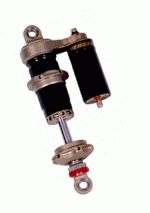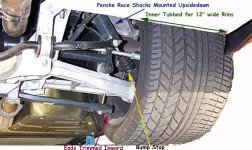You are using an out of date browser. It may not display this or other websites correctly.
You should upgrade or use an alternative browser.
You should upgrade or use an alternative browser.
C5 FRC Anyone ?
- Thread starter robbiew
- Start date
teamzr1
Supporting vendor
I notice this FRC was being used for what it was designed for in the past as
noticed the 3rd party aircleaner and airbridge
Decals of racing engine oil and
the Tick decal which sells their clutch master and notice next to it a braided hose with bleeder next to master
which goes to the clutch slave to move the bleeder off the slave's release bearing
Reason is during high RPM shifting the clutch pedal sticks to the floor and to replace the fluid stock
the exhaust and drivetube pan would have to come off to get to the bleeder to flush fluid
So as it is now the bleeder was moved to engine bay to make the flush real simple
When sold, this should be pointed out to the new owner, so they know the bleeder is up there
and to clean that aircleaner and then needs to coat it was aircleaner oil
noticed the 3rd party aircleaner and airbridge
Decals of racing engine oil and
the Tick decal which sells their clutch master and notice next to it a braided hose with bleeder next to master
which goes to the clutch slave to move the bleeder off the slave's release bearing
Reason is during high RPM shifting the clutch pedal sticks to the floor and to replace the fluid stock
the exhaust and drivetube pan would have to come off to get to the bleeder to flush fluid
So as it is now the bleeder was moved to engine bay to make the flush real simple
When sold, this should be pointed out to the new owner, so they know the bleeder is up there
and to clean that aircleaner and then needs to coat it was aircleaner oil
robbiew
CCCUK Member
Yes, team Zr1, spot on as i found out at the wings and wheels event at Dunsfold a few years ago, the stock Clutch system and hydraulics are no use at all when applying some spirited driving !
Also recently fitted Koni Sport upside down adjustable shocks ( ala Nascar) to save unsprung weight.
This C5 has the makings of a really well sorted vette, although has never been on a proper race circuit ( yet )
Also recently fitted Koni Sport upside down adjustable shocks ( ala Nascar) to save unsprung weight.
This C5 has the makings of a really well sorted vette, although has never been on a proper race circuit ( yet )
teamzr1
Supporting vendor
Being I had lowered my 1999 C5 as low as it would go I then went with the Penske race shocks also designed to be shorter and mounted
upsidedown to reduce unspung weight.
I then added a bump stop at bottom end to prevent bottoming out
I then mini tubbed the inner fenders and trimmed the end of springs, so 12-inch wide rims would fit and not showing past the rear quarter panel


These are further adjusted by Nitrogen, some info on that :
The nitrogen charge in gas shocks is essential to keep them working properly.
If the charge is too low, the oil will break down and the damper won't perform correctly and consistently.
Adding gas pressure above the minimum required will simulate a stiffer spring rate in the suspension, as now a higher force is required to compress the shock and spring due to the added force from the gas charge acting on the cross-section area of the damper shaft.
Although the shaft diameter isn't massive (5/8"), pressure acting on this will have an effect.
The canister knob affects compression damping only. If you have a knob with 6 positions. 1 = softest, 6 = stiffest.
If C5 is bottoming out over big bumps or the car feels like it's moving around too much, try going to a stuffer setting.
If the car feels too harsh and lacking grip, go to a softer setting.
The rebound adjuster will be at the other end of the shock on the end of the chrome shaft.
This adjuster makes the rebound stiffer when you turn it clockwise.
This adjuster controls roll stiffness and will help if the car takes a few oscillations to settle down after a bump.
Again, if the car feels like it's moving around too much or a bit lazy on turn in, I will want to go to a stiffer setting.
If the car gets a little tail happy or light in the rear when on the brakes, you may want to add a little rear rebound.
If the car is under steering, say on a corner out on power, I may want to add some front rebound.
upsidedown to reduce unspung weight.
I then added a bump stop at bottom end to prevent bottoming out
I then mini tubbed the inner fenders and trimmed the end of springs, so 12-inch wide rims would fit and not showing past the rear quarter panel


These are further adjusted by Nitrogen, some info on that :
The nitrogen charge in gas shocks is essential to keep them working properly.
If the charge is too low, the oil will break down and the damper won't perform correctly and consistently.
Adding gas pressure above the minimum required will simulate a stiffer spring rate in the suspension, as now a higher force is required to compress the shock and spring due to the added force from the gas charge acting on the cross-section area of the damper shaft.
Although the shaft diameter isn't massive (5/8"), pressure acting on this will have an effect.
The canister knob affects compression damping only. If you have a knob with 6 positions. 1 = softest, 6 = stiffest.
If C5 is bottoming out over big bumps or the car feels like it's moving around too much, try going to a stuffer setting.
If the car feels too harsh and lacking grip, go to a softer setting.
The rebound adjuster will be at the other end of the shock on the end of the chrome shaft.
This adjuster makes the rebound stiffer when you turn it clockwise.
This adjuster controls roll stiffness and will help if the car takes a few oscillations to settle down after a bump.
Again, if the car feels like it's moving around too much or a bit lazy on turn in, I will want to go to a stiffer setting.
If the car gets a little tail happy or light in the rear when on the brakes, you may want to add a little rear rebound.
If the car is under steering, say on a corner out on power, I may want to add some front rebound.
Last edited:
lolmeercatz
New user
Hi Robbie, have called and sent a text, if it's still available i'm local and can buy this week! Look forward to hearing from you.
Llewelyn
CCCUK Member
I owned this very car recently ! (sadly the Testicle number plate isn't on it any more!) Tristram owned it from new until if I remember correctly around 2009. It was a standard UK Coupe not an FRC.View attachment 19029
This was Tristram Reed's car back in 2002 on a trip to Beaulieu, it was an Electron Blue Coupe not the same as Jason's Nassau Blue FRC.
Still in fabulous condition and still a beautiful car!
robbiew
CCCUK Member
Yes I see your point, I have had Two c5 coupes, but in the FRC, there are NO squeaks or rattles/ vibrations, tight as a drum, a very secure feeling !Looks nice in black, but for me part of the corvette coupe’s appeal was the ability to remove its roof panels/panel. Being a rag top lover, the coupe offered nearly a convertible experience .
teamzr1
Supporting vendor
Looks nice in black, but for me part of the corvette coupe’s appeal was the ability to remove its roof panels/panel. Being a rag top lover, the coupe offered nearly a convertible experience .
The 1999 Billy Bob was built to weigh lighter and have a tighter frame/chassis with a solid roof
It was also used as a testpig as what the C5 Z06 should have.
Be nice as a weekend racer with some decent engine mods
robbiew
CCCUK Member
Even lighter now with titanium Z06 exhaust, I have also removed Air con compressor ( v. heavy) condensor, all related pipework pipework, auxillary belt and idler bearing, these components have been kept, and can be easily refitted if desired, was looking to replace drivers power seat ( v heavy) with a manual seat, if you can ever find one !The 1999 Billy Bob was built to weigh lighter and have a tighter frame/chassis with a solid roof
It was also used as a test pig as what the C5 Z06 should have.
Be nice as a weekend racer with some decent engine mods
if that is done should be a fairly lightweight car, With a Wortech tune/remap should be up to early Z06 Power. that was the long term plan, however now been diagnosed with Arthritis of the spine, I am finding it increasingly difficult to get in/out of the old girl.
Mr. Cricket
Committee Member
Defo one to get and know that you won't be wearing the same dress at the show!
Surprised it hasn't sold yet but maybe it's the right price and time of the year now
Surprised it hasn't sold yet but maybe it's the right price and time of the year now
robbiew
CCCUK Member
Maybe........ had this c5 nearly Four years , best One ive had, ( Two previous c5 s ), had some fun times at speedfest, Dunsfold wings and wheels, Goodwood breakfast clubs, and quite a few club events, but due to my increasing immobility issues, it will be a very reluctant sale, if it happens, if not you may see it as One of those barn finds, in another Twenty or Thirty years time 
Mr. Cricket
Committee Member
I also had two C5 coupes back in the day and I still maintain it's the best value for money Corvette you can get. I have too many already or this one would be in the garage but it will sell. Best of luck with the spine thing, a nasty place for painMaybe........ had this c5 nearly Four years , best One ive had, ( Two previous c5 s ), had some fun times at speedfest, Dunsfold wings and wheels, Goodwood breakfast clubs, and quite a few club events, but due to my increasing immobility issues, it will be a very reluctant sale, if it happens, if not you may see it as One of those barn finds, in another Twenty or Thirty years time


